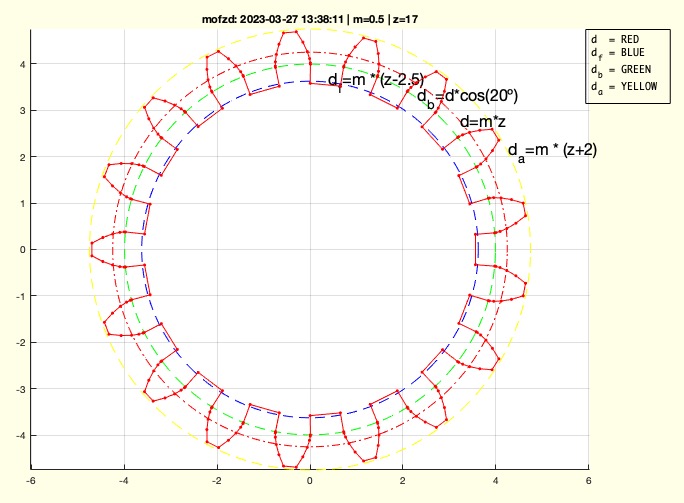mofzd
by Tim C. Lueth, SG-Lib Toolbox: SolidGeometry 5.6 - Kinematics and Frames
Introduced first in SolidGeometry 5.3, Creation date: 2023-03-25, Last change: 2025-09-15
returns the module if diameter and number of teeth are known
See Also: PLgearDIN
Example Illustration

Syntax
m=mofzd(z,d)
Input Parameter
z: | | number of teeth |
d: | | diameter of gear |
Output Parameter
Examples
mofzd (17,9)
Copyright 2023-2025 Tim C. Lueth. All rights reserved. The code is the property of Tim C. Lueth and may not be redistributed or modified without explicit written permission. This software may be used free of charge for academic research and teaching purposes only. Commercial use, redistribution, modification, or reverse engineering is strictly prohibited. Access to source code is restricted and granted only under specific agreements. For licensing inquiries or commercial use, please contact: Tim C. Lueth
Algorithm (Workflow)
This function calculates the module of a gear given the number of teeth and the diameter. It is part of the SolidGeometry library.
Input Parameters
- z: Number of teeth on the gear.
- d: Diameter of the gear.
Output Results
- m: The module of the gear.
Algorithm Explanation
- Calculate the effective module
me using the formula: me = d / (z + 2).
- Round the effective module
me to the nearest 0.1 using the function rounddiv(me, 0.1) to get the final module m.
- If no output is requested (
nargout == 0), perform the following actions:
- Call
SGfigure to possibly create a new figure for visualization.
- Call
PLgearDIN(m, z) to plot or process the gear with the calculated module and number of teeth.
- Call
sprintftext(me) to display or log the effective module.
Example
To calculate the module for a gear with 17 teeth and a diameter of 9 mm, use the function call: mofzd(17, 9).
Algorithm explaination created using ChatGPT on 2025-08-18 22:05. (Please note: No guarantee for the correctness of this explanation)
Last html export of this page out of FM database by TL: 2025-09-21